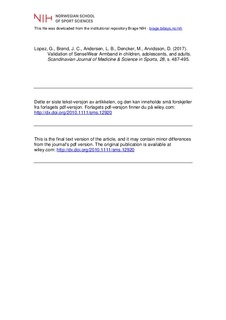| dc.contributor.author | Lopez, Garcia | |
| dc.contributor.author | Brønd, Jan Christian | |
| dc.contributor.author | Andersen, Lars Bo | |
| dc.contributor.author | Dencker, Magnus | |
| dc.contributor.author | Arvidsson, Daniel | |
| dc.date.accessioned | 2018-05-15T09:42:34Z | |
| dc.date.available | 2018-05-15T09:42:34Z | |
| dc.date.created | 2018-01-15T12:53:53Z | |
| dc.date.issued | 2017 | |
| dc.identifier.citation | Scandinavian Journal of Medicine & Science in Sports. 2017, 28, 487-495. | nb_NO |
| dc.identifier.issn | 0905-7188 | |
| dc.identifier.uri | http://hdl.handle.net/11250/2498135 | |
| dc.description | I Brage finner du siste tekst-versjon av artikkelen, og den kan inneholde ubetydelige forskjeller fra forlagets pdf-versjon. Forlagets pdf-versjon finner du på wiley.com / In Brage you'll find the final text version of the article, and it may contain insignificant differences from the journal's pdf version. The definitive version is available at wiley.com | nb_NO |
| dc.description.abstract | SenseWear Armband (SW) is a multisensor monitor to assess physical activity and energy expenditure. Its prediction algorithms have been updated periodically. The aim was to validate SW in children, adolescents, and adults. The most recent SW algorithm 5.2 (SW5.2) and the previous version 2.2 (SW2.2) were evaluated for estimation of energy expenditure during semi-structured activities in 35 children, 31 adolescents, and 36 adults with indirect calorimetry as reference. Energy expenditure estimated from waist-worn ActiGraph GT3X+ data (AG) was used for comparison. Improvements in measurement errors were demonstrated with SW5.2 compared to SW2.2, especially in children and for biking. The overall mean absolute percent error with SW5.2 was 24% in children, 23% in adolescents, and 20% in adults. The error was larger for sitting and standing (23%-32%) and for basketball and biking (19%-35%), compared to walking and running (8%-20%). The overall mean absolute error with AG was 28% in children, 22% in adolescents, and 28% in adults. The absolute percent error for biking was 32%-74% with AG. In general, SW and AG underestimated energy expenditure. However, both methods demonstrated a proportional bias, with increasing underestimation for increasing energy expenditure level, in addition to the large individual error. SW provides measures of energy expenditure level with similar accuracy in children, adolescents, and adults with the improvements in the updated algorithms. Although SW captures biking better than AG, these methods share remaining measurements errors requiring further improvements for accurate measures of physical activity and energy expenditure in clinical and epidemiological research. | nb_NO |
| dc.description.abstract | Validation of SenseWear Armband in children, adolescents, and adults | nb_NO |
| dc.language.iso | eng | nb_NO |
| dc.subject | ActiGraph | nb_NO |
| dc.subject | energy expenditure | nb_NO |
| dc.subject | indirect calorimetry | nb_NO |
| dc.subject | multisensor | nb_NO |
| dc.subject | physical activity | nb_NO |
| dc.title | Validation of SenseWear Armband in children, adolescents, and adults | nb_NO |
| dc.title.alternative | Validation of SenseWear Armband in children, adolescents, and adults | nb_NO |
| dc.type | Journal article | nb_NO |
| dc.type | Peer reviewed | nb_NO |
| dc.description.version | acceptedVersion | nb_NO |
| dc.source.pagenumber | 487-495 | nb_NO |
| dc.source.volume | 28 | nb_NO |
| dc.source.journal | Scandinavian Journal of Medicine & Science in Sports | nb_NO |
| dc.identifier.doi | 10.1111/sms.12920 | |
| dc.identifier.cristin | 1542837 | |
| dc.description.localcode | Seksjon for idrettsmedisinske fag / Department of Sport Medicine | nb_NO |
| cristin.unitcode | 150,34,0,0 | |
| cristin.unitname | Seksjon for idrettsmedisinske fag | |
| cristin.ispublished | true | |
| cristin.fulltext | postprint | |
| cristin.qualitycode | 2 | |
